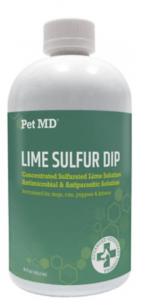Lime sulfur is registered with the EPA for agricultural uses as well as for topical application to treat mites and “mange” in livestock. A recent “interim guidance” was issued in December of 2019 that required a label change for pesticide use to include language about the possibility of pesticide drift. None of this impacts the use or availability of lime sulfur products for veterinary applications in the USA.
Some companies have discontinued their lime sulfur products. Dechra technical support staff reports it is due to their raw ingredient supplier’s discontinuation of sales to pet product companies related to this label change in the EPA’s guidance. While Dechra will not be producing more lime sulfur, what is in distribution is fine and available for sale. Company reps are being told to recommend Dechra’s Malaseb® 2% Miconazole/2% Chlorhexidine shampoo.
Vetoquinol also discontinued its lime sulfur product last year because it was not profitable.
But other companies are still manufacturing lime sulfur products. For example, Revival Animal Health, the company behind the Vet Basics line, said that they were planning to continue making their product, had no difficulties getting the base

chemicals, no shortages, and no anticipated issues filling orders. Davis Manufacturing said they are still making their lime sulfur products, and have seen some extra orders, but have plenty in stock. Pet MD said they are continuing to manufacture and experiencing no shortages, though their product is only distributed through Chewy.
Note: your veterinary products provider may not stock these specific brands, but they can all be ordered directly from the companies that make them, or from Amazon or Chewy.
Compounding is available in Canada through Chiron but is a lot more expensive and may be limited. Wedgewood-Diamondback compounding pharmacies (they merged) do not make the product. Northeast Compounding Pharmacy said that they do not currently compound lime sulfur because it is readily available. However, if all of the other companies stop manufacturing lime sulfur and the raw ingredients are available, they’d be willing to try. Worth a call to your local compounder if this happens!
Alternative treatments and what we know about them:
2% Miconazole/2% Chlorhexidine shampoo is effective as an adjunctive treatment for dermatophytosis along with an appropriate oral antifungal when diluted 1:1 and used twice weekly. The time to cure is longer than for appropriately concentrated Lime Sulfur or Enilconazole (if you live in a place where you can get it) on the order of a couple weeks, and some study cats required rescue treatment with lime sulfur. Products containing just miconazole or just chlorhexidine are not equivalent.
Accelerated Hydrogen Peroxide shampoos such as Ogena’s Pure Oxygen/Peroxiwash have not stood up well in preliminary side-by-side tests likely because shampoos have no residual antifungal activity. We do not know the optimum concentration or frequency of bathing. There are as yet no published studies about in vivo use of this product against dermatophytosis, though some may be in the works. If this is the only anti-fungal product you have, it is certainly better than nothing. Topical sprays (and mousses) such as 1% clotrimazole, 1% terbinafine, or 2% miconazole/2% chlorhexidine might help provide residual activity if used after shampooing with one of the above products. These have only been tested in vitro. We don’t know whether you need to spray just the lesions you see or the whole cat. Some of these are pricy.
If using these alternative treatments, be very careful about how you culture. This is because when using products without residual activity, the spore counts go down and then back up depending on how recently you shampooed. Best practice is to take a full body toothbrush sample just before shampooing. That way your spore count is as high as it is going to get. Be prepared for a lot of positives. Wood’s lamp and PCR are not as trustworthy because glowing hair and dead spores are detectable long after cats are culture negative. But if that’s what you have available, use it!
~This information was provided by:
 Lena DeTar, DVM, DACVPM, DABVP-SMP
Lena DeTar, DVM, DACVPM, DABVP-SMP
Position Statements Chair, Association of Shelter Veterinarians
Maddie’s Shelter Medicine Program
Cornell University College of Veterinary Medicine
**Thank you very much to Becky Stuntebeck, Linda Jacobson, and Karen Moriello for help with this guidance!


